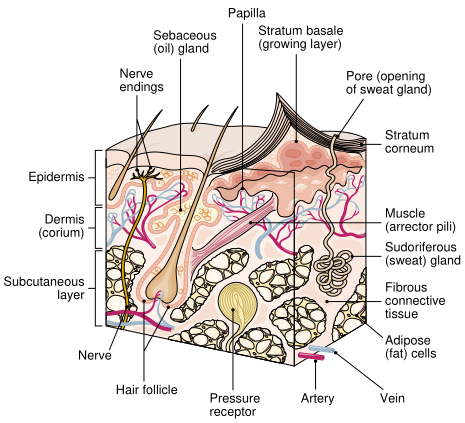The outermost portion of the skin is the epidermis, consisting of 4 to 5 layers (strata) of epithelial cells (Fig.1). The deepest layer, the stratum basale, or basal layer, produces new cells. As these cells gradually rise toward the surface, they die and become filled with keratin, a protein that thickens and toughens the skin. The outermost (horny) layer of the epidermis, the stratum corneum, is composed of flat, dead, protective cells that are constantly being shed and replaced. Some of the cells in the epidermis produce melanin, a pigment that gives color to the skin and protects against sunlight.
The dermis is beneath the epidermis. It is composed of connective tissue, nerves, blood vessels, and lymphatics. This layer supplies support and nourishment for the skin. The subcutaneous tissue beneath the dermis is composed mainly of connective tissue and fat.

FIGURE 1. Cross-section of the skin. (Reprinted with permission from Cohen BJ, Wood DL. Memmler's The Human Body in Health and Disease. 9th Ed. Philadelphia: Lippincott Williams & Wilkins, 2000.)
责任编辑:admin
上一篇:医学文章阅读——Dermatitis
下一篇:医学文章阅读——Multiple System Disorders Involving Muscles

微信公众号搜索“译员”关注我们,每天为您推送翻译理论和技巧,外语学习及翻译招聘信息。